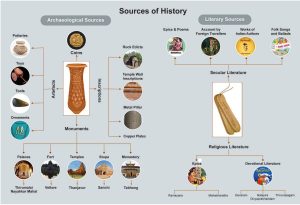What is History – TNPSC (English)
What is History
Introduction
• History is the study of past events in chronological order.
• The term history has been derived from the Greek word “Istoria” which means ‘learning by enquiry’.
Sources of History
• The written and the archaeological evidences that tell us about the period in which people lived, events,food habits, customs, culture, forms of government and literature are known as historical evidences.
• History can be divided into three parts as prehistory, proto history and historical period.
• Historical period has a proof of written evidences and other evidences.
• The written evidences are literary work, historical notes, stone edicts, copper plates and palm leaves.

Prehistory
• The period between the use of first stone tools and the invention of writing systems is pre-history.
• Stone tools excavated materials and rock paintings are the major sources of pre-history.
Proto History
• The period between pre-history and history is called Proto History.
• The period for which records in writing are available but not yet deciphered is called proto history.
Classification of prehistory

Old Stone Age
- Old Stone age also called as Paleolithic age.
- Period of old stone age is before 10,000 BCE.
- The Old Stone Age sites are widely found in various parts of the Indian subcontinent.
- These sites are generally located near water sources.
- Several rock shelters and caves used by the Paleolithic people are scattered across the subcontinent.
- They also lived rarely in huts made of leaves.
The sites of Old stone age were
- The Soan valley and Potwar Plateau – Northwest India
- The Siwalik hills – North India
- Bhimpetka – Madhya Pradesh
- Adamgarh hill – Narmada valley
- Kurnool – Andhra Pradesh
- Attirampakkam – Chennai
Middle Stone Age
- The next stage of human life is called Mesolithic or Middle Stone Age which falls roughly from 10,000 B.C. to 6000 B.C.
- It was the transitional phase between the Paleolithic Age and Neolithic Age.
The sites of the Middle stone age were
- Langhanj – Gujarat
- Adamgarh – Madhya Pradesh
- some places of Rajasthan, Uttar Pradesh and Bihar
New Stone Age
- A remarkable progress is noticed in human civilization in the Neolithic Age.
- It is approximately dated from 6000 B.C to 4000 B.C.
The sites of the new stone age were
- Kashmir valley
- Chirand in Bihar
- Belan valley in Uttar Pradesh and in several places of the Deccan.
The sites which found in south India
- Karnataka – Maski, Brahmagiri, Hallur, Kodekal
- Paiyampalli- Tamil Nadu
- Utnur – Andhra Pradesh
Metal Age
- The Neolithic period is followed by Chalcolithic (copper-stone) period when copper and bronze came to be used.
- Metal Age is dated from 3000 – 1000 BCE.
- The new technology of smelting metal ore and crafting metal artifacts is an important development in human civilization.
- Most importantly, the Harappan culture is considered as a part of Chalcolithic culture.
Some of the important sites are
- Hallur and Maski – Karnataka
- Nagarjunakonda – Andhra Pradesh
- Adichanallur – Tamil Nadu